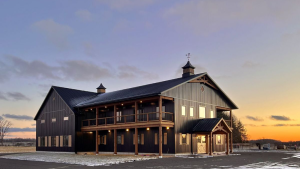Members of the Canadian Farm Builders Association (CFBA) are being encouraged to review long-awaited proposed changes to the National Farm Building Code (NFBC) in the coming months that include significant revisions to building size requirements, wind and snow loads and even a recommendation to fold the NFBC itself into the National Building Code (NBC).
The NFBC was neglected for many years since it was last revised in 1995 and since then farm buildings have gotten larger and much more complex, CFBA building code specialist Will Teron told delegates attending the association’s annual meeting in Stratford, Ont. recently.
Teron spoke to the delegates as a CFBA representative on the Canadian Commission on Building and Fire Codes Joint Task Group (JTG) on farm buildings.
“The process is slow but we are making progress and we are at the cusp of new requirements to reflect the industry and where it’s going,” Teron explained in an interview.
A set of recommendations should be released for stakeholder review within four months, he said.
“We will certainly be requesting that all of our members and everyone involved, not just farm builders but building officials and the farmers themselves, and suppliers, have input on what the requirements are, because this is going to reflect the requirements for the next decade,” said Teron.
As an example of the need for the voice of farm builders to be heard, Teron described one debate involving JTG participants on compulsory sprinklers. Given the cost involved, and that the farm building code is intended to save human lives and not property, including animals, that seems to be a non-starter for the farm building community.
“The purpose of the farm building requirements is the protection of persons in farm buildings,” said Teron. “I am under no illusion that sprinklers help with fire suppression in any building. But there is a practical side of it, with the environment of farm buildings and the stated purpose of the farm building code.
“I know there is a lobby out there advocating for the protection of farm animals but right now it is not part of the mandate so it is not considered.”
A standing committee on farm buildings was disbanded in 1996 and Teron, an engineer with Tacoma Engineers, said farm building code issues fell off the radar for awhile. Lobbying started in 2006 and the call went out to incorporate new farm building trends into the building code in 2012. The JTG was established in 2016. It is hoped that the current set of revisions being advocated can be incorporated into the model National Building Code (NBC) update set for 2020, and then provinces will consider incorporating the changes into provincial building codes with those revisions possible by 2022 or 2023, Teron said.
He described the advantages of farm building codes becoming part of the NBC and the National Fire Code in future.
“The benefits are, it will now be active in every code cycle update. All of the requirements will be reviewed by the fire protection subcommittee, the structural subcommittee, the seismic subcommittee, every code cycle,” he explained.
The current review is dealing with large farm buildings, Teron said, with the next cycle proposed to re-examine small buildings.
The three biggest changes in Teron’s view reflect the size of farm building, increasing wind loads and the need for better fire department access.
Farm buildings will now be able to be built to unlimited sizes.
“While recognizing the focus on protection of the person, so long as people are able to exit the building safety, are warned of the circumstances and the risks and are able to exit burns safely, the requirements are being relaxed on an artificial limit on the size of a building,” he said.
Wind loads will be increased from one in 10 years’ prevention to one in 50 years. This will significantly increase bracing and shearwalls in new barns, said Teron.
Farm buildings will be in category G in the new NBC with four divisions of occupancy: high-hazard farm buildings, standard farm buildings, greenhouses and farm buildings with no human occupancy. It is recommended that typical farm buildings may be up to three storeys, built of combustible materials and of unlimited area. In Teron’s presentation he said restrictions on high-hazard farm buildings are still being debated and options could include non-combustible construction but limited size, or sprinklers.





Recent Comments